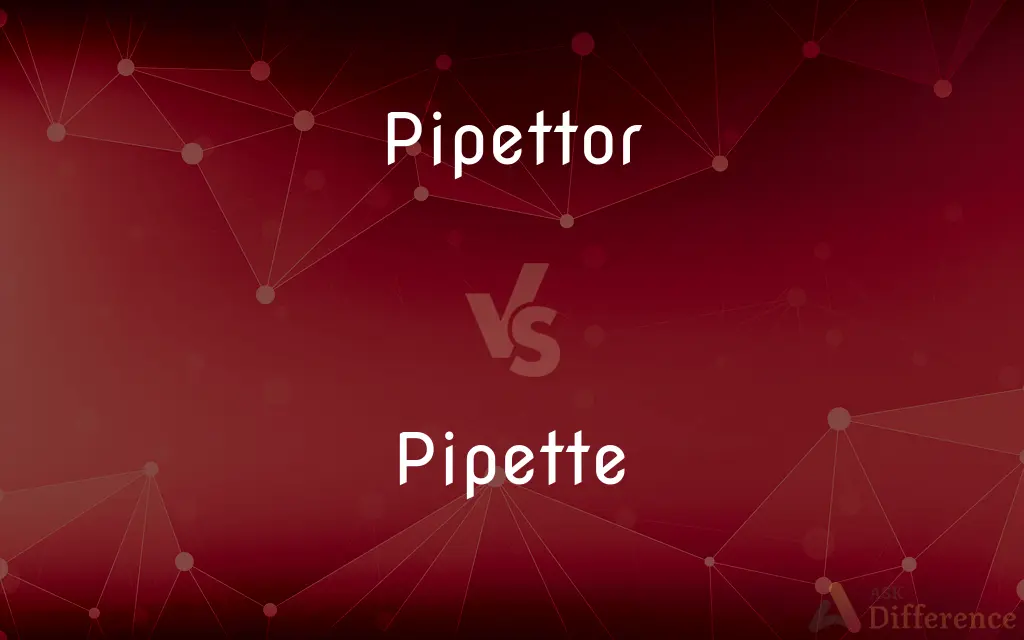Pipettor vs. Pipette — What's the Difference?
By Tayyaba Rehman & Fiza Rafique — Updated on April 28, 2024
Pipettors are mechanical devices used to measure and transfer precise liquid volumes, while pipettes are simpler tools that can be either graduated or volumetric.

Difference Between Pipettor and Pipette
Table of Contents
ADVERTISEMENT
Key Differences
A pipettor is a mechanical instrument designed to dispense specific volumes of liquids, offering precision and repeatability. Pipettes, on the other hand, are often manually operated and come in various forms such as graduated and volumetric pipettes, which are used for measuring and transferring liquids but with less precision compared to pipettors.
Pipettors are equipped with adjustable volume settings, allowing users to dispense multiple, precise volumes without needing multiple tools. Pipettes generally have fixed volumes or graduated marks for measuring, which requires more care and skill to achieve the desired accuracy.
The design of pipettors often includes ergonomic features to reduce the strain on users during repetitive use, making them suitable for intensive laboratory work. Whereas traditional pipettes are simpler and do not typically feature ergonomic designs, which can lead to fatigue during extensive use.
Modern pipettors can be electronic, enhancing their ability to provide consistent results with minimal manual effort. Conversely, pipettes are typically non-electronic and rely entirely on manual control, which can vary in accuracy depending on the user’s technique.
Maintenance and calibration are more critical and frequent for pipettors due to their complex mechanisms and reliance on accuracy. Pipettes, while still needing regular maintenance, are simpler to calibrate and maintain due to their less intricate designs.
ADVERTISEMENT
Comparison Chart
Type
Mechanical device, often adjustable
Simple tool, may be graduated or volumetric
Precision
High precision, adjustable volumes
Lower precision, fixed or graduated volumes
Operation
Manual or electronic
Typically manual
Ergonomics
Ergonomic design for repetitive use
Less focus on ergonomic design
Maintenance
Requires frequent calibration
Easier to maintain and calibrate
Compare with Definitions
Pipettor
A device used to aspirate and dispense controlled volumes of liquids.
The lab technician used a pipettor to prepare precise dilutions.
Pipette
Relies on gravity and manual control to operate.
Using a pipette requires steady hands for accuracy.
Pipettor
A tool in molecular biology for handling chemical solutions.
Accurate DNA sampling requires a reliable pipettor.
Pipette
Comes in volumetric and graduated types.
Volumetric pipettes are ideal for preparing standard solutions.
Pipettor
Requires calibration for accurate measurements.
Monthly calibration of the pipettor is essential for accurate results.
Pipette
A glass or plastic tube used to transport a measured volume of liquid.
He used a pipette to transfer the reagent.
Pipettor
Can be manual or electronic.
She preferred the electronic pipettor for its ease of use during long experiments.
Pipette
Simpler in design compared to mechanical dispensers.
The glass pipette is easier to clean and sterilize than complex instruments.
Pipettor
Often adjustable to handle different volumes.
The adjustable pipettor can measure from 1 µL to 1000 µL.
Pipette
Commonly used in chemistry and biology labs.
Every student in the lab was equipped with a pipette.
Pipettor
(chemistry) A pipette.
Pipette
A pipette (sometimes spelled pipet) is a laboratory tool commonly used in chemistry, biology and medicine to transport a measured volume of liquid, often as a media dispenser. Pipettes come in several designs for various purposes with differing levels of accuracy and precision, from single piece glass pipettes to more complex adjustable or electronic pipettes.
Pipettor
(chemistry) An automated device for pipetting.
Pipette
A narrow, usually calibrated tube into which small amounts of liquid are suctioned for transfer or measurement.
Pipette
(sciences) A small tube, often with an enlargement or bulb in the middle, and usually graduated, used for transferring or delivering measured quantities of a liquid.
Pipette
To transfer or measure the volume of a liquid using a pipette.
Pipette
A small glass tube, often with an enlargement or bulb in the middle, and usually graduated, - used for transferring or delivering measured quantities.
Pipette
Measuring instrument consisting of a graduated glass tube used to measure or transfer precise volumes of a liquid by drawing the liquid up into the tube
Common Curiosities
What types of liquids can be handled by pipettors and pipettes?
Both pipettors and pipettes can handle a range of liquids, including corrosive chemicals, provided they are made from suitable materials.
How do I clean a pipettor?
Cleaning a pipettor involves disassembling it (if possible) and sterilizing the components according to the manufacturer’s instructions.
Are pipettors more expensive than pipettes?
Yes, pipettors tend to be more expensive due to their complex mechanisms and precision capabilities.
What is the typical volume range for pipettors?
Pipettors usually cover a volume range from a few microliters up to several milliliters, depending on the design.
Can pipettes be used in place of pipettors?
Pipettes can be used in place of pipettors for less precise tasks, but they may not provide the same level of accuracy or efficiency in volume adjustment.
Is training required to use a pipettor effectively?
Effective use of a pipettor often requires specific training to ensure precision and avoid errors, especially with electronic models.
Why might a laboratory choose pipettes over pipettors?
A laboratory might choose pipettes for cost-effectiveness, simplicity, and when high precision is not critical.
What innovations have been made in pipettor design?
Recent innovations include electronic controls, programmable volumes, and designs that minimize repetitive strain injuries.
Are there disposable pipettes?
Yes, there are disposable pipettes, which are often used to prevent cross-contamination between samples.
What is the typical volume range for pipettes?
Pipettes can range from less than one milliliter up to 50 milliliters or more, particularly for graduated pipettes.
Do electronic pipettors need regular maintenance?
Yes, electronic pipettors require regular maintenance to ensure their mechanical and electronic components function properly.
How do I clean a pipette?
Pipettes are typically cleaned by rinsing with appropriate solvents and, if necessary, sterilized using heat or chemical sterilizers.
How do calibration requirements differ between pipettors and pipettes?
Pipettors generally require more frequent and stringent calibration due to their precision, while pipettes have less rigorous calibration needs.
What are the environmental impacts of using disposable pipettes?
Disposable pipettes contribute to laboratory waste, which can impact environmental sustainability efforts.
What are the main disadvantages of using pipettes?
The main disadvantages include lower precision and potential physical strain with extensive use.
Share Your Discovery

Previous Comparison
Gar vs. Pike
Next Comparison
Conveyance vs. TransportAuthor Spotlight
Written by
Tayyaba RehmanTayyaba Rehman is a distinguished writer, currently serving as a primary contributor to askdifference.com. As a researcher in semantics and etymology, Tayyaba's passion for the complexity of languages and their distinctions has found a perfect home on the platform. Tayyaba delves into the intricacies of language, distinguishing between commonly confused words and phrases, thereby providing clarity for readers worldwide.
Co-written by
Fiza RafiqueFiza Rafique is a skilled content writer at AskDifference.com, where she meticulously refines and enhances written pieces. Drawing from her vast editorial expertise, Fiza ensures clarity, accuracy, and precision in every article. Passionate about language, she continually seeks to elevate the quality of content for readers worldwide.














































